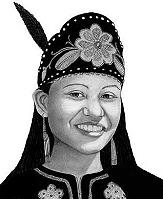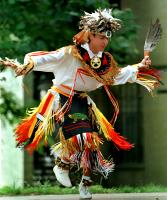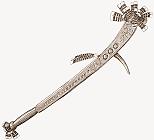 American Indian tribe index
American Indian tribe index
 Native American art
Native American artAmerican Indian language index
 American Indian tribe index
American Indian tribe index
 Native American art
Native American art

 Cayuga Indian Fact Sheet
Cayuga Indian Fact Sheet
Native American Facts For Kids was written for young people learning about the Cayuga tribe for school or home-schooling reports. We encourage students and teachers to visit our Cayuga language and culture pages for in-depth information about the tribe, but here are our answers to the questions we are most often asked by children, with Cayuga pictures and links we found suitable for all ages. Photographs are the property of the sources we have credited.



 Cayuga Tribe
Cayuga Tribe 




 How do you pronounce the word "Cayuga"? What does it mean?
How do you pronounce the word "Cayuga"? What does it mean? Where do the Cayuga Indians live?
Where do the Cayuga Indians live? Are the Cayuga Iroquois people?
Are the Cayuga Iroquois people? Iroquois flag | Yes, the Cayuga tribe was one of the original members of the Iroquois Confederacy. The other member nations were the Seneca, Oneida, Onondaga, and Mohawks. Later a sixth tribe, the Tuscarora, joined the confederacy. Today these long-term allies refer to themselves as the Haudenosaunee ("people of the longhouse") or Six Nations. |
 How is the Cayuga Indian tribe organized?
How is the Cayuga Indian tribe organized? What language do the Cayuga Indians speak?
What language do the Cayuga Indians speak? What was Cayuga culture like in the past? What is it like now?
What was Cayuga culture like in the past? What is it like now? How do Cayuga Indian children live, and what did they do in the past?
How do Cayuga Indian children live, and what did they do in the past? Cornhusk dolls | They do the same things all children do--play with each other, go to school and help around the house. Many Cayuga children like to go hunting and camping with their fathers. In the past, Indian kids had more chores and less time to play, just like colonial children. But they did have cornhusk dolls, toys, and games, such as one game where Cayuga kids tried to throw a dart through a moving hoop. Lacrosse was also a popular sport among Iroquois boys as it was among adult men. Like many Native Americans, Cayuga Indian mothers traditionally carried their babies in cradleboard carriers on their backs--a custom which many American parents have adopted. |
 What were men and women's roles in the Cayuga tribe?
What were men and women's roles in the Cayuga tribe? What were Cayuga homes like in the past?
What were Cayuga homes like in the past? Iroquois longhouse sketch |
The Cayuga Indians lived in villages of longhouses, which are large
wood-frame buildings covered with sheets of elm bark. Cayuga long houses were up to a hundred feet long, and each one was home to an entire clan
(up to 60 people.)
Here are some pictures of longhouses like
the ones Cayuga Indians used, and a
drawing of what a long houses were up to a hundred feet long, and each one was home to an entire clan
(up to 60 people.)
Here are some pictures of longhouses like
the ones Cayuga Indians used, and a
drawing of what a long house
looked like on the inside. Today, longhouses are only built for ceremonial purposes. Most Cayugas live in modern houses and apartment buildings, just like you. house
looked like on the inside. Today, longhouses are only built for ceremonial purposes. Most Cayugas live in modern houses and apartment buildings, just like you.
|
 What was Cayuga clothing like? Did they wear feather headdresses and face paint?
What was Cayuga clothing like? Did they wear feather headdresses and face paint? Cayuga headdress  Cayuga warrior |
Cayuga men wore breechcloths with leggings. Cayuga women wore wraparound skirts with shorter leggings.
Men did not originally wear shirts in the Cayuga culture, but women often wore a poncho-like tunic called an overdress or kilt.
Cayuga Indian people usually wore deerskin moccasins on their feet.
In colonial times, the Cayugas adapted European costume such as cloth shirts and blouses, decorating
them with fancy beadwork and ribbon applique. Here is a webpage
about traditional Iroquois dress, and some photographs
and links about American Indian clothes in general.
The Cayugas didn't wear long headdresses like the Sioux. Iroquois men wore a gustoweh, which is a traditional feathered cap with a different insignia for each tribe--the Cayuga headdress has one eagle feather trailing behind. Women sometimes wore beaded tiaras. In times of war, Cayuga men often shaved their heads except for a scalplock or a crest down the center of their head (the style known as a roach, or a "Mohawk.") Sometimes they would augment this hairstyle with splayed feathers or artificial roaches made of brightly dyed porcupine and deer hair. Here are some pictures of these different kinds of Native American headdress. Cayuga Indian women only cut their hair when they were in mourning. Otherwise they wore it long and loose or plaited into a long braid. Here is a website with pictures of these Native hairstyles. Men sometimes tattoed their faces and bodies with tribal designs, but Cayuga women generally didn't paint or tattoo themselves. Today, some Cayuga people still wear moccasins or a beaded shirt, but they wear modern clothes like jeans instead of breechcloths... and they only wear feathers in their hair on special occasions like a dance. |
 What was Cayuga transportation like in the days before cars? Did they paddle canoes?
What was Cayuga transportation like in the days before cars? Did they paddle canoes? Snowshoes | Sometimes--the Cayuga Indians did use elm-bark or dugout canoes for fishing trips, but usually preferred to travel by land. Here is an article with pictures of different Indian canoe types. Originally the Cayuga tribe used dogs as pack animals. (There were no horses in North America until colonists brought them over from Europe.) In wintertime, the Cayugas used laced snowshoes and sleds to travel through the snow. |
 What was Cayuga food like in the days before supermarkets?
What was Cayuga food like in the days before supermarkets? Iroquois farmers | The Cayuga tribe were farmers. Cayuga women planted crops of corn, beans, and squash and harvested wild berries and herbs. Cayuga men hunted deer and elk and fished in the rivers and on the shores of Lake Ontario. Cayuga Indian recipes included cornbread, soups, and stews, which they cooked on stone hearths. Here is a website with more information about North American Indian food. |
 What were Cayuga weapons and tools like in the past?
What were Cayuga weapons and tools like in the past? Iroquois war club |
Cayuga hunters used bows and arrows. Cayuga fishermen used spears and fishing poles with bone hooks.
In war, Cayuga men used their bows and arrows or fought with heavy war clubs and shields.
Here is a website with pictures and more information about Iroquois Indian weapons.
Other important tools used by the Cayuga tribe included stone adzes (hand axes for woodworking), flint knives for skinning animals, and wooden hoes for farming. The Cayugas and other Iroquois were skilled woodworkers, steaming wood so that it could be bent to make curved tools. Some Iroquois artisans still make lacrosse sticks this way today. |
 What are Cayuga arts and crafts like?
What are Cayuga arts and crafts like?  Beadwork amulet | The Cayuga tribe was known for their mask carving, which is considered such a sacred art form that non-Iroquois are still not permitted to view many of these masks. Iroquois beadwork and the more demanding porcupine quillwork are more common Cayuga crafts. The Cayuga Indians also crafted wampum out of white and purple shell beads. Wampum beads were traded as a kind of currency, but they were more culturally important as an art material. The designs and pictures on wampum belts often told a story or represented a person's family. |
 What was Cayuga music like?
What was Cayuga music like? Cayuga water drum | The two most important Cayuga instruments are drums and flutes. Iroquois drums were often filled with water to give them a distinctive sound different from the drums of other tribes. Most Cayuga Indian music is very rhythmic and consists mostly of drumming and lively singing. Flutes were used to woo women in the Cayuga tribe. A young Cayuga man would play beautiful flute music outside his girlfriend's longhouse at night to show her he was thinking about her. |
 What other Native Americans did the Cayuga tribe interact with?
What other Native Americans did the Cayuga tribe interact with? What kinds of stories do the Cayuga Indians tell?
What kinds of stories do the Cayuga Indians tell? What about Cayuga religion?
What about Cayuga religion? Can you recommend a good book for me to read?
Can you recommend a good book for me to read? How do I cite your website in my bibliography?
How do I cite your website in my bibliography?
 Cayuga Native Americans
Cayuga Native Americans
 Cayuga Dictionary
Cayuga Dictionary
 Cayuga Culture and History Directory
Cayuga Culture and History Directory
 Iroquois Confederacy
Iroquois Confederacy

Return to American Indians for Children
Return to our menu of Native American cultures

American Indian heritage
 Indiana tribes
Indiana tribes
 Navajo county
Navajo county
 American Indian jewelry
American Indian jewelry
Would you like to help support our organization's work with endangered American Indian languages?